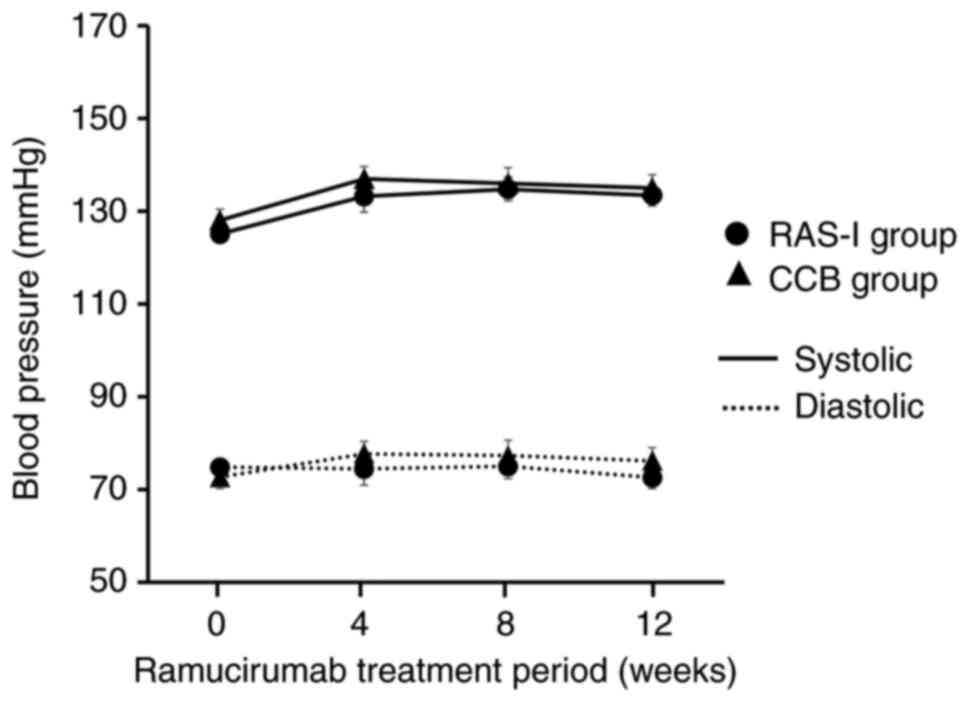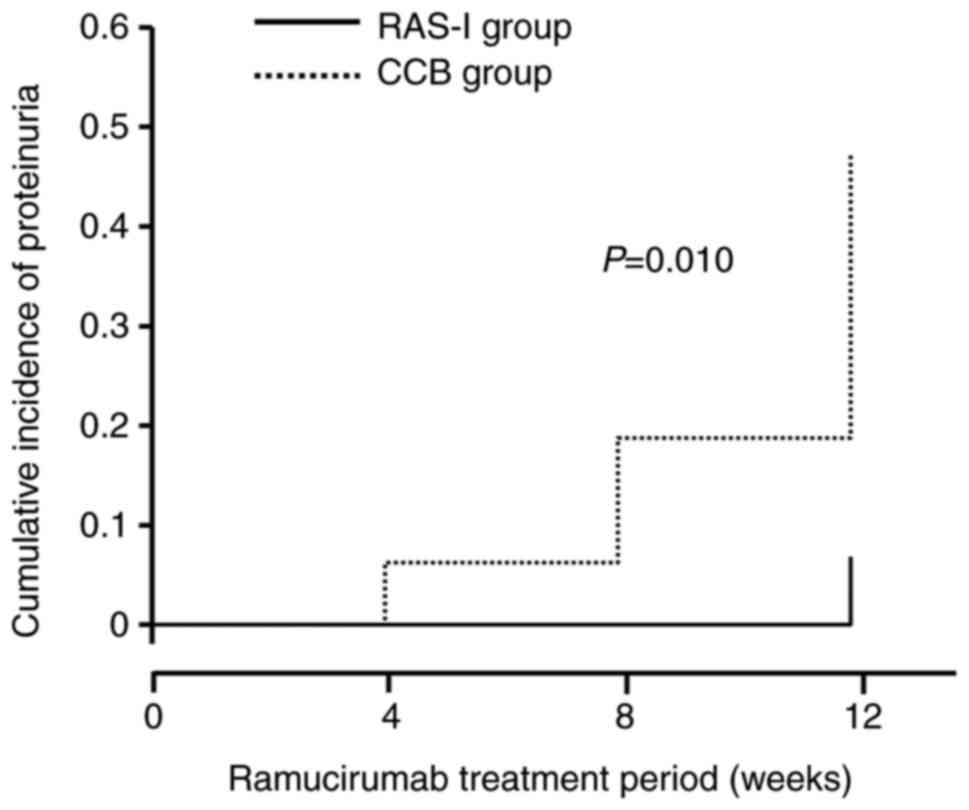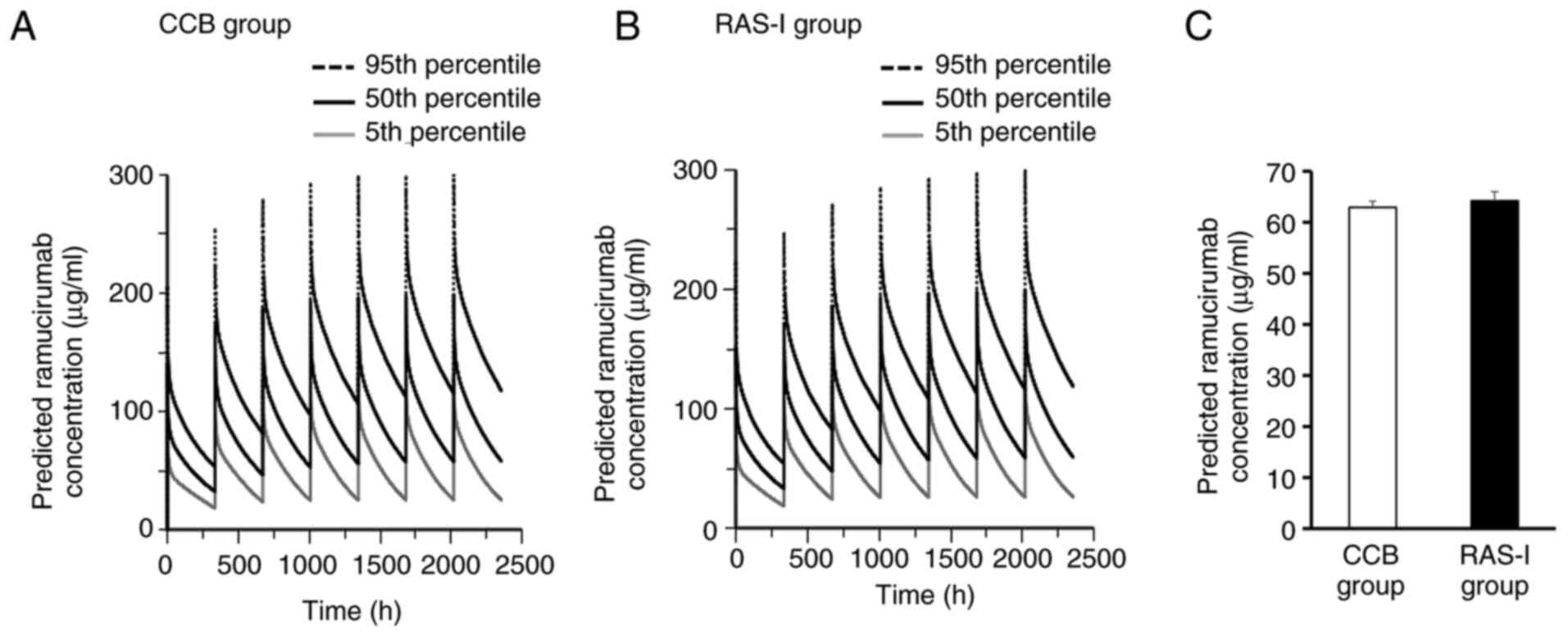|
1
|
Lu D, Jimenez X, Zhang H, Bohlen P, Witte
L and Zhu Z: Selection of high affinity human neutralizing
antibodies to VEGFR2 from a large antibody phage display library
for antiangiogenesis therapy. Int J Cancer. 97:393–399.
2002.PubMed/NCBI View
Article : Google Scholar
|
|
2
|
Lu D, Shen J, Vil MD, Zhang H, Jimenez X,
Bohlen P, Witte L and Zhu Z: Tailoring in vitro selection for a
picomolar affinity human antibody directed against vascular
endothelial growth factor receptor 2 for enhanced neutralizing
activity. J Biol Chem. 278:43496–43507. 2003.PubMed/NCBI View Article : Google Scholar
|
|
3
|
Ferrara N: Vascular endothelial growth
factor. Arterioscler Thromb Vasc Biol. 29:789–791. 2009.PubMed/NCBI View Article : Google Scholar
|
|
4
|
Suzuki T, Shinozaki E, Osumi H, Nakayama
I, Ota Y, Ichimura T, Ogura M, Wakatsuki T, Ooki A, Takahari D, et
al: Second-line FOLFIRI plus ramucirumab with or without prior
bevacizumab for patients with metastatic colorectal cancer. Cancer
Chemother Pharmacol. 84:307–313. 2019.PubMed/NCBI View Article : Google Scholar
|
|
5
|
De Vita F, Borg C, Farina G, Geva R,
Carton I, Cuku H, Wei R and Muro K: Ramucirumab and paclitaxel in
patients with gastric cancer and prior trastuzumab: Subgroup
analysis from RAINBOW study. Future Oncol. 15:2723–2731.
2019.PubMed/NCBI View Article : Google Scholar
|
|
6
|
Arnold D, Fuchs CS, Tabernero J, Ohtsu A,
Zhu AX, Garon EB, Mackey JR, Paz-Ares L, Baron AD, Okusaka T, et
al: Meta-analysis of individual patient safety data from six
randomized, placebo-controlled trials with the antiangiogenic
VEGFR2-binding monoclonal antibody ramucirumab. Ann Oncol.
28:2932–2942. 2017.PubMed/NCBI View Article : Google Scholar
|
|
7
|
Yamaguchi K, Fujitani K, Nagashima F,
Omuro Y, Machida N, Nishina T, Koue T, Tsujimoto M, Maeda K and
Satoh T: Ramucirumab for the treatment of metastatic gastric or
gastroesophageal junction adenocarcinoma following disease
progression on first-line platinum- or fluoropyrimidine-containing
combination therapy in Japanese patients: A phase 2, open-label
study. Gastric Cancer. 21:1041–1049. 2018.PubMed/NCBI View Article : Google Scholar
|
|
8
|
Abdel-Rahman O and ElHalawani H:
Proteinuria in patients with solid tumors treated with ramucirumab:
A systematic review and meta-analysis. Chemotherapy. 60:325–333.
2014.PubMed/NCBI View Article : Google Scholar
|
|
9
|
Zhao T, Wang X, Xu T, Xu X and Liu Z:
Bevacizumab significantly increases the risks of hypertension and
proteinuria in cancer patients: A systematic review and
comprehensive meta-analysis. Oncotarget. 8:51492–51506.
2017.PubMed/NCBI View Article : Google Scholar
|
|
10
|
Gordon MS and Cunningham D: Managing
patients treated with bevacizumab combination therapy. Oncology. 69
(Suppl 3):S25–S33. 2005.PubMed/NCBI View Article : Google Scholar
|
|
11
|
Feliu J, Salud A, Safont MJ, García-Girón
C, Aparicio J, Losa F, Bosch C, Escudero P, Casado E, Jorge M, et
al: Correlation of hypertension and proteinuria with outcome in
elderly bevacizumab-treated patients with metastatic colorectal
cancer. PLoS One. 10(e0116527)2015.PubMed/NCBI View Article : Google Scholar
|
|
12
|
Nihei S, Sato J, Harada T, Kuyama S,
Suzuki T, Waga N, Saito Y, Kisara S, Yokota A, Okada K, et al:
Antiproteinuric effects of renin-angiotensin inhibitors in lung
cancer patients receiving bevacizumab. Cancer Chemother Pharmacol.
81:1051–1059. 2018.PubMed/NCBI View Article : Google Scholar
|
|
13
|
Matsuo S, Imai E, Horio M, Yasuda Y,
Tomita K, Nitta K, Yamagata K, Tomino Y, Yokoyama H and Hishida A:
Collaborators developing the Japanese equation for estimated GFR.
Revised equations for estimated GFR from serum creatinine in Japan.
Am J Kidney Dis. 53:982–992. 2009.PubMed/NCBI View Article : Google Scholar
|
|
14
|
O'Brien L, Westwood P, Gao L and Heathman
M: Population pharmacokinetic meta-analysis of ramucirumab in
cancer patients. Br J Clin Pharmacol. 83:2741–2751. 2017.PubMed/NCBI View Article : Google Scholar
|
|
15
|
R Core Team: R: A language and environment
for statistical computing. R Foundation for Statistical Computing,
Vienna, 2012. http://www.R-project.org/.
|
|
16
|
Carneiro T, Nobrega RVMD, Nepomuceno T,
Bian GB, Albuquerque VHCD and Filho APP: Performance Analysis of
Google Colaboratory as a Tool for Accelerating Deep Learning
Applications. IEEE Access. 6:61677–61685. 2018.
|
|
17
|
Umemura S, Arima H, Arima S, Asayama K,
Dohi Y, Hirooka Y, Horio T, Hosihde S, Ikeda S, Ishimitsu T, et al:
The Japanese society of hypertension guidelines for the management
of hypertension (JSH 2019). Hypertens Res. 42:1235–1481.
2019.PubMed/NCBI View Article : Google Scholar
|
|
18
|
Zhang Z, Meszaros G, He WT, Xu Y, de
Fatima Magliarelli H, Mailly L, Mihlan M, Liu Y, Puig Gámez M,
Goginashvili A, et al: Protein kinase D at the Golgi controls NLRP3
inflammasome activation. J Exp Med. 214:2671–2693. 2017.PubMed/NCBI View Article : Google Scholar
|
|
19
|
Kanesaki Y, Suzuki D, Uehara G, Toyoda M,
Katoh T, Sakai H and Watanabe T: Vascular endothelial growth factor
gene expression is correlated with glomerular neovascularization in
human diabetic nephropathy. Am J Kidney Dis. 45:288–294.
2005.PubMed/NCBI View Article : Google Scholar
|
|
20
|
Pandey AK, Singhi EK, Arroyo JP, Ikizler
TA, Gould ER, Brown J, Beckman JA, Harrison DG and Moslehi J:
Mechanisms of VEGF (vascular endothelial growth factor)
inhibitor-associated hypertension and vascular disease.
Hypertension. 71:e1–e8. 2018.PubMed/NCBI View Article : Google Scholar
|
|
21
|
Haraldsson B, Nyström J and Deen WM:
Properties of the glomerular barrier and mechanisms of proteinuria.
Physiol Rev. 88:451–487. 2008.PubMed/NCBI View Article : Google Scholar
|
|
22
|
Thamcharoen N, Susantitaphong P,
Wongrakpanich S, Chongsathidkiet P, Tantrachoti P, Pitukweerakul S,
Avihingsanon Y, Praditpornsilpa K, Jaber BL and Eiam-Ong S: Effect
of N- and T-type calcium channel blocker on proteinuria, blood
pressure and kidney function in hypertensive patients: A
meta-analysis. Hypertens Res. 38:847–855. 2015.PubMed/NCBI View Article : Google Scholar
|
|
23
|
Batova S, DeWever J, Godfraind T,
Balligand JL, Dessy C and Feron O: The calcium channel blocker
amlodipine promotes the unclamping of eNOS from caveolin in
endothelial cells. Cardiovasc Res. 71:478–485. 2006.PubMed/NCBI View Article : Google Scholar
|
|
24
|
Yuen DA, Stead BE, Zhang Y, White KE,
Kabir MG, Thai K, Advani SL, Connelly KA, Takano T, Zhu L, et al:
eNOS deficiency predisposes podocytes to injury in diabetes. J Am
Soc Nephrol. 23:1810–1823. 2012.PubMed/NCBI View Article : Google Scholar
|
|
25
|
Nakamura T, Inoue T, Suzuki T, Kawagoe Y,
Ueda Y, Koide H and Node K: Comparison of renal and vascular
protective effects between telmisartan and amlodipine in
hypertensive patients with chronic kidney disease with mild renal
insufficiency. Hypertens Res. 31:841–850. 2008.PubMed/NCBI View Article : Google Scholar
|
|
26
|
Rüster C and Wolf G:
Renin-angiotensin-aldosterone system and progression of renal
disease. J Am Soc Nephrol. 17:2985–2991. 2006.PubMed/NCBI View Article : Google Scholar
|
|
27
|
Huang PL: eNOS, metabolic syndrome and
cardiovascular disease. Trends Endocrinol Metab. 20:295–302.
2009.PubMed/NCBI View Article : Google Scholar
|
|
28
|
Goumenos DS, Tsakas S, El Nahas AM,
Alexandri S, Oldroyd S, Kalliakmani P and Vlachojannis JG:
Transforming growth factor-beta(1) in the kidney and urine of
patients with glomerular disease and proteinuria. Nephrol Dial
Transplant. 17:2145–2152. 2002.PubMed/NCBI View Article : Google Scholar
|
|
29
|
Das R, Xu S, Quan X, Nguyen TT, Kong ID,
Chung CH, Lee EY, Cha SK and Park KS: Upregulation of mitochondrial
Nox4 mediates TGF-β-induced apoptosis in cultured mouse podocytes.
Am J Physiol Renal Physiol. 306:F155–F167. 2014.PubMed/NCBI View Article : Google Scholar
|
|
30
|
Nagasu H, Satoh M, Fujimoto S, Tomita N,
Sasaki T and Kashihara N: Azelnidipine attenuates glomerular damage
in Dahl salt-sensitive rats by suppressing sympathetic nerve
activity. Hypertens Res. 35:348–355. 2012.PubMed/NCBI View Article : Google Scholar
|
|
31
|
Suehiro T, Tsuruya K, Yoshida H, Tsujikawa
H, Yamada S, Tanaka S, Tsuchimoto A, Eriguchi M, Fujisaki K, Torisu
K, et al: Stronger effect of azilsartan on reduction of proteinuria
compared to candesartan in patients with CKD: A randomized
crossover trial. Kidney Blood Press Res. 46:173–184.
2021.PubMed/NCBI View Article : Google Scholar
|
|
32
|
Yen CJ, Kudo M, Lim HY, Hsu CH, Vogel A,
Brandi G, Cheng R, Nitu IS, Abada P, Hsu Y, et al: Efficacy and
safety of ramucirumab in Asian and non-Asian patients with advanced
hepatocellular carcinoma and elevated alpha-fetoprotein: Pooled
individual data analysis of two randomized studies. Liver Cancer.
9:440–454. 2020.PubMed/NCBI View Article : Google Scholar
|












